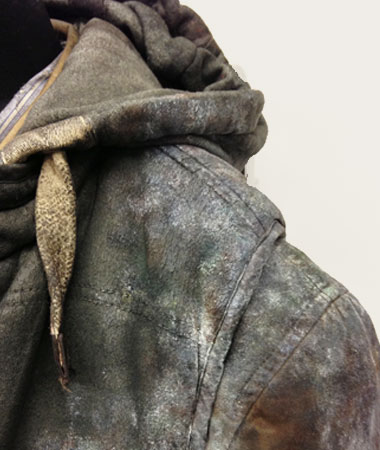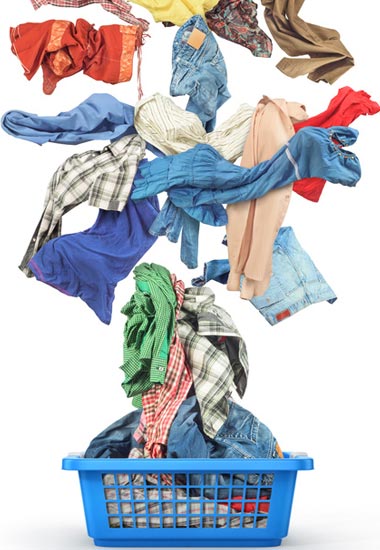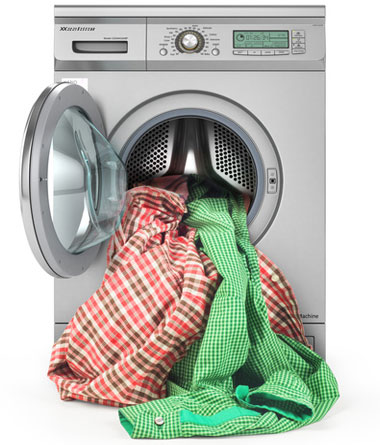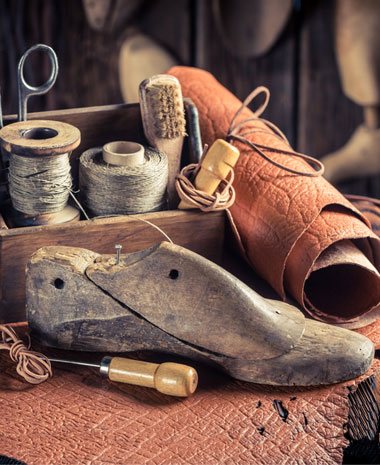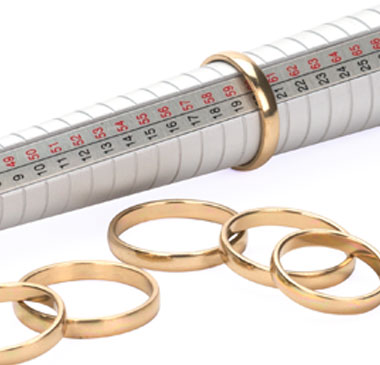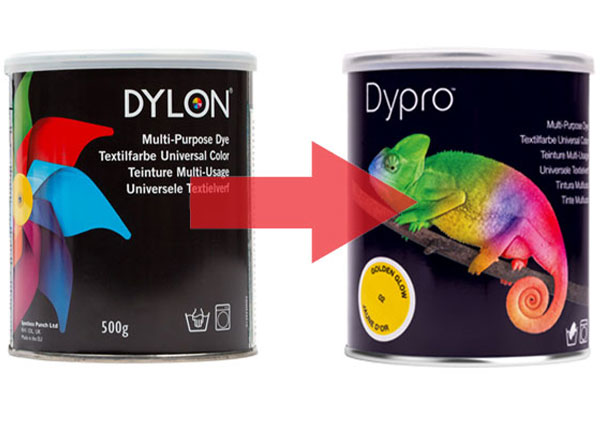PATIN-A Blog – Based on Experience
This blog shows how to patinate correctly, gives tips for the work in the costume department, shows the newest trends and introduces products and their use.
The main focus lies on costume distressing, leather working and textile dyeing. We show trends of the trade and aids for costume design.
FAQs about dyeing with Textile Dyes

Fabric dyeing with textile dyes
We gathered all customers questions in this little 'Dye-Wiki' and really hope we can give helpful answers to all the problems and issues about dyeing ;-)
In the PATIN-A fabric dyeing range we exclusively carry high-quality dyes by Rit Dye, DEKA, Jacquard and Dypro (DYLON).
However, many questions and answers about the subject of 'DYEING' are generally valid.
About the use: Just click on a question in the list - you shall immediately be redirected to the right text passage.
General Information about Dyeing
• Which fabrics can be dyed resp. not dyed?
• Do textiles have to be discoloured before dyeing?
• At which temperature do I have to dye?
• How can I tell whether the dye is a hot water dye or a cold water dye?
• Why do I have to use salt for dyeing?
• Is fixing after dyeing necessary?
• What is the meaning of 'full shade' or 'half shade' dye?
• I would like an intensive shade - do I have to take more dye than the amount specified?
• Is it possible to mix different products?
• Can shades be mixed which are not part of the range?
• Can I dye garments in the microwave?
• I would like to dye by hand - what do I need and what should I pay attention to?
• Tie-dye: Can I keep textile dye which I have already mixed?
• Tie-dye: according to experience, how much dye do I need for one T-shirt?
• Can I apply textile dyes with a paintbrush?
• What's the point of colour charts and where can I get them?
• How much does my garment or my bedlinen weigh?
• Which dye should I chose - Dypro (DYLON) - Jacquard or DEKA?
• Where do the DYLON dyes come from and how do you pronounce the name of the brand?
How do I dye... what?
• What is the right way to tie-dye?
• What is better - machine dyeing or hand dyeing?
• Can I redye my wedding dress?
• How do I dye polyamide or nylon?
• How do I dye buttons and 3D prints?
• How do I dye polyacrylic and polyester?
• Can I dye down feathers and microfiber clothing?
Problems and solutions
• I do not know the composition of the fabric I want to dye - can I find out myself?
• Can I cover stains by dyeing?
• Why does my fabric show stripes and/or dark stains after dyeing?
• Why does the dyed colour look different than the colour on the pack's label?
• What is going to happen if I have used too much salt?
• Does dyeing in the machine affect subsequent washes?
• How can I remove dye from my fingers?
• Why do I have tiny little coloured dots on the fabric after dyeing?
• Why were the seams not dyed?
Environmental and health issues
• Is dyeing environmentally compatible?
• Are textile dyes harmful to my baby?
Answers:
General information about Dyeing
The 'dye liquor' does not come from the liquor store ... it's the liquid, in which the textile is dyed.
Dye liquor contains all the components which are necessary for dyeing.
» Which fabrics can be dyed - or not dyed?
As a rule: only washable textiles can be dyed! Before dyeing, it is therefore absolutely essential to read the instructions on the care label.
Natural fibers / processed natural products:
Basically, natural fibers and processed natural products can be dyed without any problems (careful though: cellulose fibers may shrink up to 10% when dyed at 60°C)
Wool and silk should only be dyed by hand.
Mixed materials consisting of natural and synthetic fibers:
Mixed materials with less than 30% synthetics can be dyed with a dye for natural fibres (the result will not be as intensive as with 100% natural fibres)
Blends of natural and synthetic fibres can very well be dyed iDye Textile Dyes . A mix of iDye Poly and iDye Natural dyes the textile 100%.
Another product can also manage this: Rit DyeMore for synthetic fibres along with Rit DyeMore for natural fibres.
Synthetic fibres:
Polyamide (nylon) and elastane:
Dypro (DYLON) Universal Color, Rit DyeMore and iDye Poly dye synthetic fibres like polyamide (nylon), elastane.
• Polyester:
Polyester can be dyed with iDye Poly or Rit DyeMore.
• Polyacrylic and mixed materials with a proportion of acrylic:
Polyacrylics can be dyed with Jacquard Basic Dye and Rit DyeMore !
Faulty dyes on synthetic fibres are very difficult to discolour. For that purpose, we recommend Rit Color Remover or Jacquard iDye Color Remover.
You will find very detailed information on fibres can be dyed with which dyes in our blog post: What textile dye should I take for what material?
» Do textiles have to be discoloured before dyeing?
Not always - if you dye a dark colour on a light fabric, you do not have to discolour. But the other way round you should, when dyeing a light or brilliant tone on a dark fabric.
In the PATIN-A SHOP, we carry a selection of different colour strippers for pretreatment of a garment to be dyed:
Rit Color Remover, iDye Color Remover und Dylon Pre Dye are perfect for lightening of dark fabrics. After discouloring the textiles can be dyed in bright colours.
However it may not - or not sufficiently - be possible to discolour some industrially dyed fabrics with the colour strippers available on the market.
» At which temperature do I have to dye?
The manufacturer always indicates the dye temperature. Hot dyes should be dyed at 60ºC at least (better 80 - 85ºC) and cold dyes should be dyed in hand warm water at 40ºC to 60ºC .
Synthetic fibres like polyamide, elastane, nylon need 80ºC and polyester even a dye temperature of 93ºC.
We carry in our range hot water dyes and cold water dyes.
» How can I tell whether the dye is a hot water dye or a cold water dye?
Hot water dyes have a dye temperature of at least 60°C (better 80°C - 85°C) and cold water dyes need hand warm water (40°C).
Hot water dyes: iDye Textile Dyes, Dypro (DYLON) Multi-Purpose Dye , DEKA Textile Dye L , Jacquard Basic Dye and Rit DyeMore (for an intense dye you need to start with a temperature of 85ºC), iDye Poly and Rit DyeMore need 93ºC.
Cold water dyes: Indigo, DEKA Machine Dyes und DEKA Textile Dye aktuell - dye at 40ºC.
» Why do I have to use salt for dyeing?
Salt is necessary for opening the pores of the fibers in order to allow the dye to penetrate.In addition to that, salt makes some dyes, especially dark dyes, dye more intensively. In the PATIN-A SHOP you will get a special dye salt which allows the dye to penetrate the fibre more easily and more deeply. Blue shades will be more intense.
For wool or silk though you should never use salt (the fibers would be damaged - saltwater by the sea also harms your hair and makes it brittle)! Instead, use vinegar. For one dye I use 75 ml of vinegar essence (150ml for white vinegar).
One dash of vinegar in the last rinse makes silk beautifully shiny again.
» Is fixing after dyeing necessary?
First of all you should know with which type of dye you have dyed - that will tell you whether you need a fixing agent or not.
Die hot water dyes iDye Natural, DEKA 'L' , Jacquard Basic Dye, Rit All-Purpose Dye und Dypro (DYLON) Multi-Purpose Dye contain no fixing agent - unlike the cold water dyes: Jacquard Procion MX, DEKA Machine Dye und DEKA 'aktuell'.
If you want to wash the garments dyed with hot water dyes more often, then it is essential that you use a fixative right after dyeing.
Hot water dyes = an extra fixative is required
Cold water dyes = an extra fixative is not required. In internet forums, you can often read that fabrics should be fixed with vinegar. Please forget about this, as it will work only under certain conditions (in fact it does not!)!
For fixing textiles, we recommend these professional fixing products: Rit ColorStay, DyproFix, iDye Fixative or ' or 'DEKA 111L'
- Every fixing agent is used in a different way. Please read the product description or the enclosed instruction leaflet.
- After fixing you can wash your textiles as usual at up to 40ºC.
Feel free to mix new colours if you think our 100 different shades are not enough!
Here are some examples:
Red and blue = violet
Blue and yellow = green
Red and yellow = orange
Light green and light blue = turquoise
It is very easy to mix dyes. Creating thousands of new shades is magical!
On the colour wheel you can see which colours you get when you mix two tones.
There is a great, easy-to-use theory of colours: the Color-Wheel - a mixing aid for everyone who wants to mix colours. By simply turning the colour wheel and you will immediately get the right colour mixture.
Rit Dye offers something really special: the Rit Color Formulars.
They allow you to mix very easily thousands of shades with very precise millilitre indication of the required colours.
Test it - it's super fun! Here is the link: Color Formulars

» What is the meaning of 'full shade' or 'half shade' dye?
On the dye pack it says that this pack of textile dye is meant for 500g of fabric.
It reads: to achieve a 100% full tone, do not dye more than 500g of fabric.
That is 'full tone'.
Dye 1000g of textiles with the same amount of dye and you will get a half-tone dye (you can also dye only 500g of fabric and use only half of the content of the box).
If you want to dye 2000g of textiles with one pack of dye then you will get a very pastel quarter tone (this works also for 500g of fabric and a quarter dye pack).
| Full tone | Half tone | Quarter tone |
| 1 dye pack | 1/2 dye pack | 1/4 dye pack |
| 1 fixative pack | 1/2 fixative pack | 1/4 fixative pack |
Full Tone (=Vollton) / Half Tone (=Halbton) / Quarter Tone (=Viertelton)
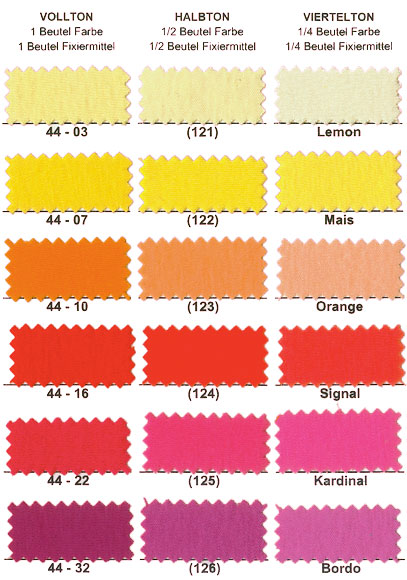
» I would like an intensive shade - do I have to take more dye than the amount specified?
The most intensive tone you can achieve is the full tone.It is important to know the dry weight of the textile to add the right amount of dye and dye salt.
Just to be sure: leave dark colours a bit longer as recommended in the dye liquor.
» Is it possible to mix different products?
Please do not mix different dye products!
Most of them have different chemical components and the dye result would be uncertain!
» Can shades be mixed which are not part of the range?
Within one product range you can mix all shades with one another, creating thousands of new colour tones out of the 24 to 30 ones we offer.
Dissolved dyes mix best.
If you need a specific shade to be mixed quickly without much testing, Rit Dye has the solution: the Rit Color Formulars.
They allow you to mix very easily thousands of shades with precise millilitre indication of the required colours.
Test it - they have been developed by professionals and are extremely precise! Here is the link: Color Formulars
» Can I dye garments in the microwave?
For dyeing in the microwave we recommend DEKA aktuell or Jacquard Procion MX.
Dyeing in the microwave achieves beautiful TIE DYE effects.
If you would like to achieve an even dye result though, do without the microwave and dye in a pot or in the washing machine.
» I would like to dye by hand - what do I need and what should I pay attention to?
This is what you need:
• a pot or bucket or large bowl
• rubber gloves
• a wooden spoon or stick
• (dye)salt or vinegar
• textile dye
• fixing agent
For further info please refer to: 'Differences in the use of hot water dyes and cold water dyes'.
Dye Equipment:
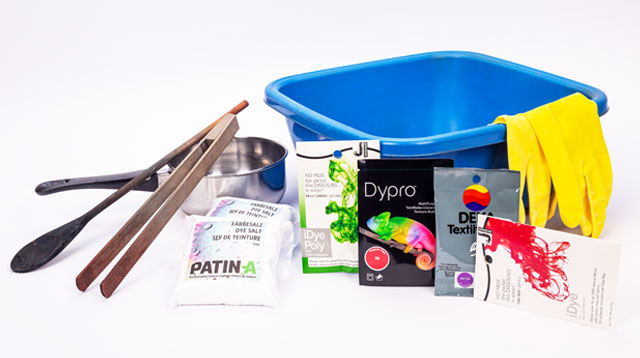
For cold water dyes use any large bowl or pot and for hot water dyes use only a cooking pot. The bigger - the better!
The pot's capacity should be at least five, or better seven liters.
Take a stainless steel pot, if you have one! In this one no pigments will remain!
My personal preference goes to an electrical preserver with drain valve and a capacity of 30 liters (these pots are also known as 'mulled wine pot' or 'canning pot'. They cost between 70 and 150 euro and with a bit of luck and for very little money you can purchase these great pots by auction in summer).
These electrical preservers are very good because they can keep a constant temperature of 60° (or higher) thanks to their built-in heating surface.
This allows a trouble-free dyeing even of big textiles for a longer period of time.
After dyeing, do not use the pot for mulled wine etc. any more!
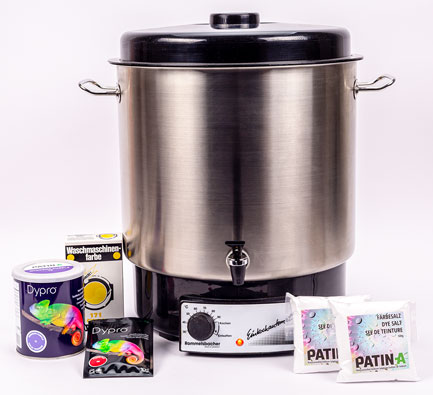
» Tie-Dye: Can I keep textile dye which I have already mixed?
As long as there is no salt or reactive agent in the dye liquor (here: squeeze bottle), the dye can be stored and used later. The dye should not jellify.
» Tie-Dye: according to experience, how much dye do I need for one T-shirt?
The size of your group is relevant alone.
How many colours do you want to dye the T-shirts or how many different colours do you want to provide (tie-dye works of art usually come in more than one colour)?
You need one pack of DEKA 'aktuell' Textile Dye or Jacquard Procion MX. per colour. But a good idea is to use three base colours so you can mix a lot of beautiful shades!
If you want to tie-dye with a number of children (summer camp or birthday party), plan 1 pack of dye per child.
An experienced tie-dyer will only need little dye - newcomers spill a lot...
For applying the dyes for tie-dye, we recommend our 250 ml or 500 ml Squeeze Bottle with the red nozzle (empty washing-up liquid bottle, shampoo or drinking bottles work well too).
In our blog post for tie dye batik we show you very precisely how easy and fun it is to tie-dye with kids.
Perfect squeeze bottle for TIE-DYE:
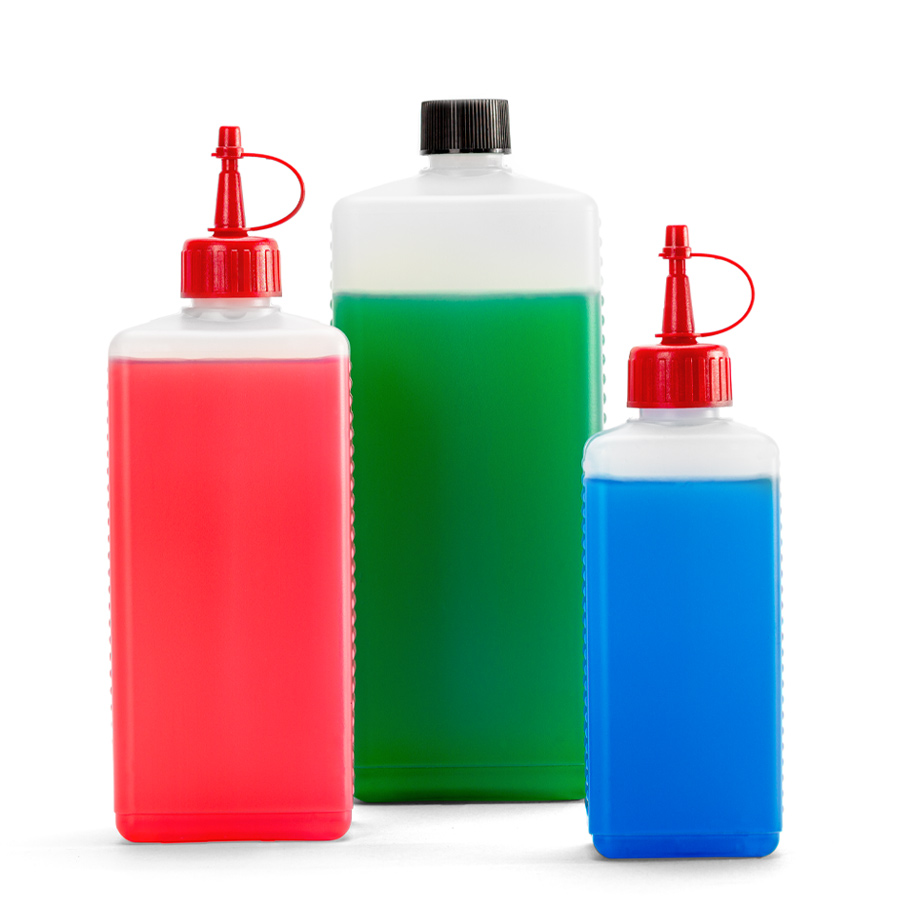
» Can I apply textile dyes with a paint brush?
I'm afraid this will not work very well!
The damp fabric will absorb the dye and spread it generously like blotting paper. But if this is the effect you want, then of course you can apply dyes with a paint brush and fix them with the tie-dye technique.
» What's the point of colour charts and where can I get them?
Colour charts (especially those with dyed cotton as reference) should not be missing in any dyer's workshop.
They're useful for precise selecting of a colour and for choosing the right base dyes. RAL-colour fans make sense to copy colour shades. We carry colour charts from DEKA and Dypro (DYLON) at cost price. Link: Colour charts
Colour charts for dyeing:
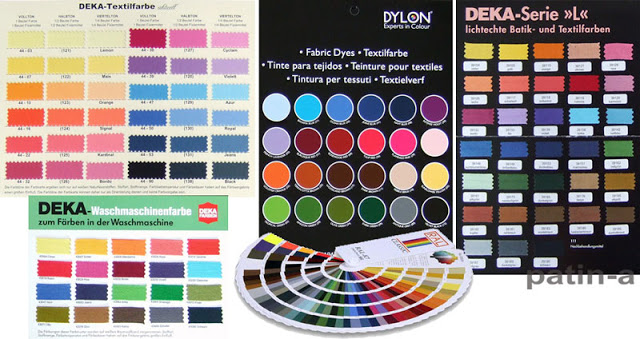
» How much does my garment or my bedlinen weigh?
Most kitchen scales weigh up to 1000g.
Very often clothes weigh less (therefore you can weigh them yourself before dyeing).
These are only average weights:
• A pair of jeans or trousers weigh approx. 600g
• A men's shirt approx. 250g
• A blouse approx. 200g
• A T-shirt approx. 100g
• A beach towel weighs approx. 600g
• A duvet cover along with a pillow case weigh approx. 750g
» Which dye should I choose - Rit Dye, Jacquard, DEKA or Dypro (DYLON) ?
This is not an easy question, as these manufacturers have great products.
One thing is sure: they're all the same high quality!
All textile dyes by Rit, Jacquard, Dypro (DYLON) and DEKA contain high quality pigments, are easy to use and you will be thrilled by their brilliant colours!
Contrary to other dyes from the drugstore or the DIY store, these dyes are professional quality.
If you have used 'Simplicol' dyes in the past you will see the difference!
As far as our dyes are concerned, there are differences in the way they are used and in the colour shades: For DEKA 'aktuell' and Jacquard Procion MX, you also need a reactive agent.
iDye Natural, DEKA 'L', Jacquard Basic Dye, Rit All-Purpose Dye, Rit ProLine Dye, and Dypro (DYLON) Multi-Purpose Dye need, if colour fastness is required, a fixative (e.g. DEKA 111L).
Rit, Jacquard and DEKA enrich the "market of dyes" with exciting and unusual shades - Dypro (DYLON) favours a more classical palette and thanks to iDye Poly / Rit DyeMore, white seams and annoying care labels disappear.
DEKA aktuell and the DEKA Machine Dyes feature an impressive 'black'. There is no black blacker than the DEKA-black on the market! Theater dye workshops almost exclusively use DEKA aktuell and DEKA Machine Dye for dyeing costumes black.
We also sell this dye very often to fashion labels.
Another special feature of these two producers is that they also offer bulk quantities of certain dyes.
» Where do the DYLON dyes come from and how do you pronounce the name of the brand?
DYLON has been established in 1946 by the 'Mayborn Group' as 'DYLON International Limited' based in London for the production of textile dyes and household chemicals.
Dylon is the world's leading manufacturer of textile dyes for consumers with a distribution in over 70 countries. This is how the name came up:
It stems originally from 'Dyes of London'. The name of the brand was formed with the first letters: DYes of LONdon , and is pronounced the English way, of course: [ˈdīlən]
From September 2019, DYLON's professional textile dyes (Multi Purpose Dye) have been given the new brand name Dypro.
Products from the standard range: washing machine dyes and hand textile dyes will continue to be marketed under the name DYLON.
How do I dye... what?
» Can I dye fabrics white?
No, sorry, you can't! Textile dyes can only dye darker - not lighter.
Jeans made of 100% cotton can be wonderfully overdyed.
If you wish to refresh your faded jeans with a particularly authentic colour, use real Indigo. That is the blue tone of an original jeans.
We recommend for that DEKA Machine Dyes - they will dye your favourite jeans the most beautiful colours.
But please bear in mind:
the light/dark contrast of a pair of jeans will go once dyed...
Yes you can! - and that works very well too!
» What is the right way to tie-dye?
You can find detailed instructions in this blog entry: Tie Dye Batik: Dyeing Rainbow Spirals
» What is better - machine dyeing or hand dyeing?
I would always machine dye garments you can machine wash!
The instructions for use are easier to follow and the result is always perfect.
Small textiles and silk or wool though should always be hand dyed in a container or bowl.
» Can I redye my wedding dress?
I would like to dye my wedding dress and do not know how?
This question is frequently asked and for the right kind of advice is it essential to know the composition of the fabrics.
• If your wedding dress consists of mixed materials (viscose/polyester or cotton/polyester or silk/polyester etc.) or even of 100% natural fibers, dyeing is no problem.
• Lace most of the time is polyester - even very expensive lace!
• For dyeing mixed materials and natural materials, use iDye Natural along with iDye Poly
• Garments made from 100% polyester need iDye Poly or Rit DyeMore.
• To reach an intense colour tone take three times the amount of dye.
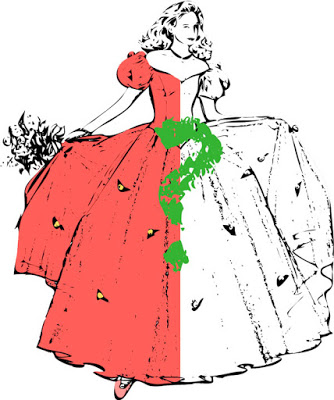
» How do I dye polyamide or nylon?
Polyamide and nylon can very well be dyed with the hot water dyes 'Dypro (DYLON) Multi-Purpose Dye', Rit DyeMore or iDye Poly.
We recommend dyeing in a cooking pot. .
» How do I dye buttons and 3D prints?
You can dye buttons and 3D prints with Rit All-Purpose Dye , iDye Poly orDypro (DYLON) Multi Purpose Dye.
For Dypro, dilute 5g of dye in 500ml of boiling water (making sure the pigments dissolve completely). Plunge up to 125g of plastic items in the dye liquor.
They have to be covered entirely with dye.
Bring the dye liquor to the boil and dye the items for 10 minutes, moving them again and again and checking whether the dye is even.
Rinse the items in water until the water runs clear.
» How do I dye polyacrylic and polyester?
Polyester und polyacryl are hard to dye!
• Polyester: With iDye Poly or Rit DyeMore you can dye polyester also at home.
• Polyacryl: Jacquard Basic Dye or Rit DyeMore dye polyacryl.
Lingerie from natural fibres, mixed fabrics or polyamide (nylon) can perfectly well be dyed. For natural fibers and mixed materials, I recommend Rit DyeMore, iDye Natural, DEKA 'L' and for polyamide or elastane, Dypro (DYLON) Multi-Purpose Dye or Rit All-Purpose Dye.
Lingerie from polyester can only be dyed with Rit DyeMore or iDye Poly
» Can I dye down feathers and microfiber clothing?
No, sorry, you can't dye garments made of downs and microfiber.
The downs would be destroyed and the microfiber does not take the colour.
» How do I dye feathers?
You need:
• Dypro (DYLON) Multi-Purpose Dye or Jacquard Acid Dye
• A cooking pot
• A wooden spoon
• Rubber gloves
• Vinegar concentrate or white vinegar
• Wool detergent and washing-up liquid
1. First of all, the feathers should be washed (and degreased). For this purpose, please take 30°- 40°C warm water, add 1 teaspoon of washing-up liquid and a little bit of wool detergent. The feathers should remain in the suds between for 15 to 30 minutes to be completely clean and grease-free. Then rinse with clear water and press slightly.
2. Completely dilute 5g of Dypro (DYLON) Multi Purpose Dye or Jacquard Acid Dye in 1/2 liter of boiling hot water. Pour the dye liquor in the cooking pot with hot water and stir. Add 1 tablespoon of vinegar (or 1 teaspoon of vinegar concentrate) per liter of water. A drop of washing-up liquid will decrease the water's surface's tension and so the dye can better penetrate the items to be dyed.
3. Put the damp feathers in the dye liquor and bring the lot to the boil on the stove, stirring carefully. The feathers should remain 30 to 40 minutes in the dye liquor to achieve an intensive dye. It will take longer for dark colours and for the colour black, it is best to leave the feathers in the dye liquor overnight. For this purpose we recommend a cooking pot with an integrated heating surface and thermostat (for instance the electrical preserver or 'mulled wine pot' mentioned above). Allow the dye liquor to cool down a bit before you take the feathers out. Please note the following carefully: After dyeing, the dyed feathers have to be rinsed thoroughly and very carefully. The rinse water should not be cooler than the dye liquor! Reduce the water temperature gradually. Avoid sudden temperature changes. You can add very little wool detergent to the water.
4. Lay the feathers on kitchen paper or on a towel to dry, or dry them with the hairdryer. You can reshape large feathers over water vapour.
Problems and Solutions
» I do not know the composition of the fabric I want to dye - can I find out myself?
Yes!
And it is very easy: Cut a little piece of fabric off (at the seam maybe for a finished garment) or try to get hold of a fibre. Hold the piece of fabric or the fibre with tweezers and light it carefully (using a lighter is best).
If the fibre decomposes to ash, then in most cases it is natural.
Synthetics, polyester for instance, melt and smell strongly of chemicals!
» Can I cover stains by dyeing?
This will only work if the desired colour is much darker then the stain.
You will achieve good results with black and dark brown.
Why not discolour your textile first? Usually stains will then disappear. We carry very effective colour strippers in our range (for pre treatment of new dyes): Rit Color Remover, iDye Color Remover und Dylon Pre Dye
» Why does my fabric show stripes and/or dark stains after dyeing?
There are several factors:
1. Finishing residues! Blotched or streaky dyes are often due to finishing residues in the textile. If you have not washed your textile previously and completely removed the residues you will automatically have streaks when dyeing. To be sure to get rid of the finishing, you have to soak the garment overnight the night before dyeing with detergent and machine wash it the following day. But you can't do this with silk as silk does not like water! For this purpose we have a special finishing remover by DEKA: DEKA Textil-Fit - Finishing Remover
A softener is also a very tenacious finishing. It is important to remove finishing also from dry cleaned textiles. Skin grease (for worn clothes) also stains! Therefore: make sure to wash the garment you want to dye very carefully or remove the finishing with the professional DEKA Textilfit Finishing Remover !
2. Not enough water! For machine dyeing, please press the "water plus" button - if there is none, add some warm water through the detergent compartment. For hand dye, please make sure that the items to be dyed are completely plunged into the dye liquor (at least 5 liters of water for 250g of fabric).
3. Stir! If you dye in a pot the item has to be moved constantly as otherwise the dye will deposit unevenly in the fabric.
4. Too much fabric in the machine!
Do not machine dye more than 1500g of fabric at the same time in your washing machine with a loading capacity of 4.5kg. If the fabric is very bulky (terry cloth for instance), then up to 1000g only. Machines with larger loading capacity can dye proportionally more textiles.
» Why does the dyed colour look different than the colour on the pack's label?
How the dyed colour tone will look depends on the textile you dye!
• The colour on the label (and on the colour chart) is always dyed on 100% white cotton. If you dye a coloured item then after dyeing you will have a mixed tone - the dye never covers completely but just stains.
• If you do not dye long enough the dye cannot penetrate deep and intensive enough into the fiber. Make sure to dye for at least 45 to 60 minutes.
• If you dye mixed fibers (for instance cotton with polyester) the result will always be lighter as expected.
• Please bear in mind that mixed materials with a polyester proportion of 50% cannot be dyed with the standard dyes (only with iDye Poly in combination with iDye Natural or Rit DyeMore with Rit All-Purpose Dye).
• Another issue is the quantity of dye! If you use too little dye the result will be accordingly lighter. And with too much dye the result will be slightly darker than on the pack.
• Do not overload your washing machine. For a 'normal' washing machine with a capacity of 4.5 kg we recommend to dye only 1000g, only exceptionally up to 1500g (1.5 kg) of dry fabric.
• For 1.5kg dry weight, please make sure to add 3 to 5 liters of water through the washing powder compartment after 5 minutes of washing cycle.
• A useful hint for machine dyeing: turn the garment inside out (for dyeing and for every wash). You will thus avoid streaks when spin-drying.
» What is going to happen if I have used too much salt?
Too much of a good thing is not necessarily better - and more is not always more but sometimes less...
Too much salt can stain the textile.
Please read the instructions carefully to find out exactly how much salt to add to your dye.
» Does dyeing in the machine affect subsequent washes?
No, usually not!
If you follow the manufacturer's recommendations and run an empty wash cycle with detergent after dyeing, all remaining pigments should have vanished.
In addition to that, what I do is wash only black clothes in the next wash (and never had problems with laundry). Customers very often enquire whether the washing machine can be ruined by dyeing: The chemicals which dye the laundry cannot undergo a bonding with any part of the machine and the remaining pigments lie only superficially on the rubber and stainless steel and disappear with the next wash.
Remove the washing powder compartment and clean it and wipe the rubber joints at the door thoroughly with a damp cloth. This is where most of the residues are located.
If after that there should still be a pigment in the machine, just run a long cycle of dark (black...) laundry.
» How can I remove dye from my fingers?
You can remove dye from your hands with any usual colour run remover.
As colour run removers may damage delicate skin, we recommend to use carefully and to wash with soap afterwards and apply cream to the skin.
» Why do I have tiny little coloured dots on the fabric after dyeing?
If you detect red or purple dots on the textile you will probably not have diluted the pigments in the dye powder properly before dyeing.
This is how you should prepare for dyeing:
Textile dye with a proportion of red should definitely be filtered through a cloth/fine pantyhose to avoid little red or purple dots (coloured spots) on the dyed fabric.
This only applies to the powder dyes iDye Natural, Dypro (DYLON) Multi Purpose Dye, DEKA L and DEKA Aktuell.
These dyes contain red pigments:
Dypro (DYLON) Multi Purpose Dye
60 Peach, 39 Tangerine, 32 Scarlet, 09 Pagoda Red, 12 Rose of Paris, 13 Carnival Pink, 44 Cerise, 10 Cherry Flame, 11 Bordeaux, 15 Windsor Purple, 34 Olive Green, 22 Reindeer Beige, 53 Desert Dust, 65 Havanna Brown, 07 Coffee
DEKA L:
Orange, Scarlet, Brilliant Red, Ruby Red, Salmon, Old Rose, Pink, Crimson, Bordo, Lilac, Violet, Chestnut, Mode Brown, Dark Brown, Old Gold und Beige
» Why were the seams not dyed??
The seams of industrially produced textiles are 100% polyester.
Polyester cannot be dyed with the usual textile dyes. For this you need a special polyester textile dye: iDye Poly or Rit DyeMore.
Environment and Health
» Is dyeing environmentally compatible?
We hear very often that dyeing damages the environment.
We think that this is only partly true: the environmental damage for new textiles is much bigger, as the fabric for new textiles has to be produced! Natural fibers have to be cleaned, bleached, mercerised, dyed and provided with a finish before the fabric can be weaved.
Most of the time clothing is manufactured in other continents meaning long transport routes.
If you dye your own clothes, you recycle them yourself and thus contribute to less fabric and clothes being produced - and along with that there will also be less pollution.
It follows that dyeing of clothes instead of buying new ones can make sense ecologically.
» Are textile dyes harmful to my baby?
Parents very often enquire whether they can dye baby clothes or baby slings.
I'm afraid we have no satisfactory answer to that as there are no well-known surveys about that matter.
As far as resistance to spittle is concerned, we cannot give a general statement for Jacquard, Dypro (DYLON) or DEKA Textile Dyes. Resistance to spittle can only be tested on the dyed fabric - not on the dye itself (it is the same problem with bought textiles)!
Different types of fabric can cause different reaction to spittle, depending on the fabric's nature. These are often cheap imported textiles dyed with dyes that are harmful to health.
Hint: The colour pigments of Jacquard Procion MX, DEKA aktuell Textile Dye and DEKA Machine Dye are reactive dyes that bond firmly with the fiber and can only be removed with bleaching agents. These dyes are used in the clothing industry for baby clothes because they do not dissolve with water and detergents. You can use these dyes without hesitation for dyeing your textiles. After dyeing, wash the garments with Synthrapol to rinse out any dye particles that are not fixed in the fiber.
Have we overlooked an important point - or do you have any questions? In that case, please complete our list and/or just ask in the comments.
Thanks a lot!
(updated 30/07/2023)
 We ship worldwide
We ship worldwide Top customer satisfaction!
Top customer satisfaction! Many payment options
Many payment options
